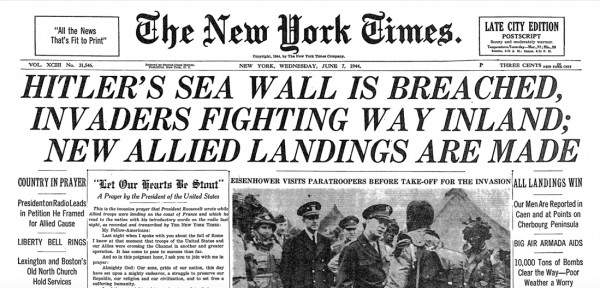Forecast for D-Day
As German soldiers peered out from their bunkers along the French coast on the morning of June 5, 1944, they knew there was no way that the long awaited invasion by the Allies was coming that day. High winds, heavy rains and huge waves were pounding the beaches all along the English Channel that day. June 5th had been the day that the invasion was scheduled to launch. But Allied weather forecasters had accurately predicted the terrible weather that occurred. If June 5th had been D-Day, the results would have been terrible.
So the forecast had been accurate, staving off a disaster, but Allied commanders were nervous. The landings depended on a complex set of factors, including tides and moonlight and other things. The early June window for invasion was about to close and would not reopen for two weeks. The element of surprise was a huge factor, and waiting an two additional weeks would reduce the Allies chance of success. So as you can see, weather was critical in the decision making process.
In April 1944, a joint Allied team of British and American forecasters had been established to create five day forecasts for commanders. A five day forecast was something that was unheard of at that time. Their first job was to pick a time that climatologically would be favorable for the invasion. They chose early June. June 5th would be the day. But weather maps on June 3rd and 4th showed a depressing situation for forecasters and military leaders. Several low pressure systems were poised to move across the invasion area over the next several days.
Allied forecasters had an advantage since their forces controlled most of the North Atlantic and weather data was more plentiful to them than to the Germans. This data revealed a small window of better weather that would occur on Tuesday, June 6th as a small ridge moved over the area between two low pressure troughs. The decision was made to go then.
Allied Forces landed on the beaches of Normandy on the morning of June 6th, 1944,, opening the long-awaited second front against the Germans and spelling the beginning of the end of World War II. The Germans were completely caught by surprise. Their military leaders believed that the Allies would wait until there six good days of weather before crossing the channel. At the end of the first day, the Allies had suffered 12,000 casualties. Commanders had expected as many as 75,000.
Weather forecasting had played an important role in the success of the operation, but a closer look reveals that the German forecast was actually better than the Allied forecast. The German predictions were actually closer to the actual wave heights, which were critical to the success of conveying men and materiel to the beaches on landing craft. The German forecast led them to them being relatively unprepared with their commander Irwin Rommel away from the field. The wave heights were actually above the critical threshold set by the Allies for invasion. If their forecast had been more correct, they might not have made the fortuitous decision to launch on June 6th.
It really makes you stop to consider the relationship between accuracy and value in a forecast and how it is interpreted by its end users. Dr. Harold Brooks eloquently discussed this in episode 322 of WeatherBrains on June 4, 2012. Listen to the podcast.
A final note: if the invasion had not occurred on the 6th, the next window of opportunity standpoint would have been the 17th through the 21st. A storm of historic proportions during that time could have proven disastrous for the invading forces.
Category: Met 101/Weather History



















